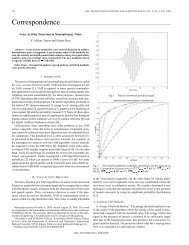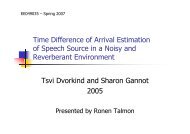Thesis (PDF) - Signal & Image Processing Lab
Thesis (PDF) - Signal & Image Processing Lab
Thesis (PDF) - Signal & Image Processing Lab
Create successful ePaper yourself
Turn your PDF publications into a flip-book with our unique Google optimized e-Paper software.
20 CHAPTER 2. THEORETICAL BACKGROUND<br />
1. x ≤ a0, ∀x ∈ X,<br />
2. if there exists y, such that x ≤ y ≤ a0, for all x ∈ X, then y = a0. One defines<br />
the greatest minorant ∧X (also called infimum) of X, dually.<br />
A partially ordered set P is an inf-semilattice (resp. sup-semilattice) if every two-<br />
element subset {X1, X2} in P has an infimum X1 ∧ X2 (resp., a supremum X1 ∨ X2)<br />
in P . If P is both an inf and a sup-semilattice, then it is called a lattice. An inf-<br />
semilattice (resp., sup-semilattice) is complete, when every non-empty subset B ⊂ P<br />
has an infimum ∧B (resp. supremum ∨B). In this case, there exists in the semilattice<br />
a unique element 0, called zero element, (resp., U, called universe), such that, for any<br />
X ∈ P , 0 ∧ X = 0 (resp. U ∨ X = U). A complete lattice is a lattice, which is both<br />
a complete inf and complete sup-semilattice.<br />
2.3.2 Morphology on Semilattices<br />
Some basic notions and tools of mathematical morphology on complete lattices were<br />
extended to semilattices in [21] by Keshet. In this section, we shortly review the<br />
extensions. Proofs of propositions will be omitted, but they are available in [21].<br />
Without loss of generality, we restrict our discussion to inf-semilattices, since all<br />
definitions and results are valid in sup-semilattices as well, by duality.<br />
Erosions and openings are basic notions that are directly and naturally extendible<br />
from complete lattices to complete inf-semilattices.<br />
Erosion is defined in complete inf-semilattice S as any operator that distributes<br />
over the infimum, see (2.4). Preservation of the universe is not required, because it<br />
does not necessarily exist in S.<br />
Definition 1. A binary operator ε in an inf-semilattice S is an erosion iff, for all<br />
{Xi} ⊆ S:<br />
ε( �<br />
Xi) = �<br />
ε(Xi) (2.4)<br />
Proposition 1. Erosions in inf-semilattices are increasing 1 .<br />
i<br />
The extension of algebraic openings to semilattices is also straightforward:<br />
1 A transform Ψ is increasing ⇔ ∀f ≤ g ⇒ Ψ(f) = Ψ(g).<br />
i
















